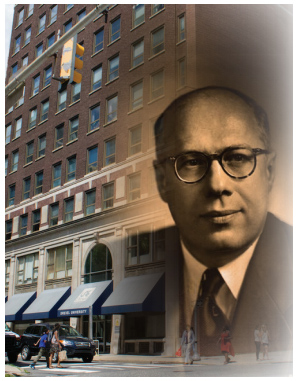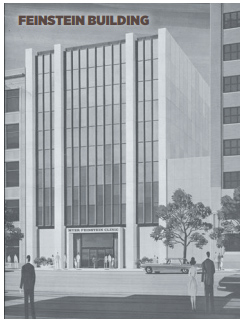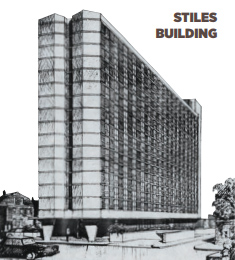Calling Dr. New: A Quick Tour of Campus Namesakes
Dr. Bellet Before He Was a Building

Purchased by Hahnemann Medical College in 1972, the Schaff (now Bellet) Building lost its easternmost portion to eminent domain in 1974 to accommodate the widening of 15th Street.
Samuel Bellet, MD (1902-1971), was a prominent Philadelphia cardiologist, considered a pioneer in the study of arrythmias. He authored more than 275 papers and four books, including Clinical Disorders of the Heart Beat, which was translated into three languages.
Born in Kiev, Russia, Bellet immigrated to the United States with his family in 1906, at the tender age of 4. (His father's first name was "Alias," which must have raised some eyebrows among the immigration officers.) Bellet grew up in Philadelphia, and earned his bachelor's degree from the University of Pennsylvania and his MD from Jefferson Medical College.
Over the years, sometimes simultaneously, Bellet served as a cardiologist at Einstein Medical Center, chief of cardiology at Philadelphia General Hospital, director of cardiovascular diseases at Graduate Hospital, professor of clinical cardiology at the University of Pennsylvania, and clinical professor of medicine at Woman's Medical College of Pennsylvania. His research contributed significantly to knowledge of the ill effects of tobacco, diet and inactivity on the heart. Bellet was so well respected that he was tapped by the Johnson Administration to serve on the President's Commission on Heart Disease, Cancer and Stroke.
In 1976, five years after Bellet's death, the former Schaff Building at 1505 Race Street was renamed in his memory. (The building had been constructed in 1923 as an addition to the Reformed Church Building, which sat right at the corner, but the addition outlived the original.) At the dedication, the salute to Bellet was delivered by William Likoff, MD, Hahnemann Class of 1938, director of the cardiovascular institute at Hahnemann, and namesake of the William Likoff Clinical Excellence Award, still given annually to a College of Medicine faculty member.

Fondly Known as Feinstein
Garages have served as the birthplace for everything from rock bands to high-tech startups — and even pristine modern medical buildings, like the one opened in the 1960s at 216 North Broad Street.
But let's back up.
There was a time when North Broad Street was Philadelphia's Automobile Row. From Cherry Street north to Girard, there were showrooms, parts shops, even manufacturers. Today, the 200 block is dominated by health care, and all the cars are being driven, or parked. Change came in stages. First, the garage at 216 N. Broad Street, owned by Keystone Motor Car Company, was remodeled into a public-facing business: a Chrysler showroom. Then, in the 1960s, Hahnemann Medical College acquired the building with plans to remodel it for ambulatory patients.
The renovation would create a complete radiology therapy center on the first floor and include facilities for diagnostic radiology, private physician's offices and procedure rooms for various medical specialties. The cost at the time was estimated at $1.9 million. More than half was accounted for, but the rest would have to come from public subscription.
Fortunately an angel stepped up. According to the late Joseph DiPalma, MD, former Hahnemann dean, the general fundraising was "greatly helped by a generous grant from Myer Feinstein, then a member of the board" (DiPalma, Decanus Maximus, Xlibris, 2004). In fact, Feinstein had been a Hahnemann trustee since 1954 and chaired the finance committee.
Myer Feinstein (1896-1965) was a notable Philadelphia banker and philanthropist. President of the Jewish Exponent weekly and a member of the national campaign cabinet of the United Jewish Appeal, he was active in more than 20 other organizations. In an editorial mourning his death, the Philadelphia Evening Bulletin credited Feinstein with bringing about a renaissance in Hahnemann Hospital. "He took the Depression as a challenge, and made a fortune, but he took that as a new challenge: to repay his debt to his country and his city."
The Myer Feinstein Polyclinic was dedicated in 1967. Charles S. Cameron, MD, president of Hahnemann Medical College and Hospital, gave the welcome. A "dedicatory dinner" and reception were held that evening at the Bellevue-Stratford Hotel.

The Latest Stiles
Named for a Hahnemann graduate, Stiles Alumni Hall was the first student residence at Hahnemann Medical College, and it remains Drexel University's only Center City dormitory. The 16-story building at 325 N. 15th Street offers one-, two- and three-bedroom apartments for upper-class and graduate students in the health sciences. Two floors are leased to the Pennsylvania Academy of the Fine Arts for their student housing.
Wendell Arthur Stiles, MD, received his bachelor's degree from Texas A&M University before making his way across the country to Hahnemann, where he graduated in 1927. True to his Texas roots, Stiles practiced internal medicine and cardiology in Dallas for nearly 50 years (with five years spent in the Army Medical Corps during WW II). In 1951, he was named to the Texas State Board of Medical Examiners.
Stiles was also true to his Hahnemann roots, for when he died in 1976, he left $1.2 million to Hahnemann Medical College, which was the largest single bequest received by the school up to that time. That led the school to christen the new student tower in his name. Joseph T. Marconis, HU '42, was the master of ceremonies at the dedication held on June 1, 1977.
Calling Dr. New
No, don't even bother. The New College Building wasn't named for an alum, a faculty member or a philanthropist. It wasn't named after anyone, actually. It does have a connection to a famous architect. But that's only a small part of the history of 245 N. 15th Street.

A Redevelopment Authority image shows the old college building on the left, Klahr on the right.
It's necessary to begin in 1886. That year, Hahnemann Medical College completed construction of an education building on North Broad Street, on what is now the site of the hospital's South Tower. Four years later, in 1890, Hahnemann completed and dedicated a 150-bed hospital at the 15th Street location.
Then, in 1928, the hospital and the college traded places.
It was part of a grand plan: Renowned architect and Philadelphia native Horace Trumbauer was engaged to design a large hospital-and-teaching complex. (Among other work, Trumbauer is known for designing mansions in Philadelphia and Newport, the Free Library of Philadelphia at Logan Circle and much of the campus of Duke University.) Hahnemann Hospital moved to its new 600-bed building at 230 N. Broad Street, site of the former college building, and the medical school moved into the 1890 hospital building on 15th Street.
Still on track? Good, because further expansion followed. In 1938, one wing of a new "Trumbauer college building" was completed — the seven-story Klahr Building, believed to be named for Pittsburgh philanthropist Emilie Klahr. The Klahr Building replaced part of the existing building facing 15th Street.
Finally, in 1966, construction began on a new college building adjacent to the Klahr Building. Built to the tune of $34 million, the new college building was partially occupied in 1972, completed in 1973, and dedicated (to no one) in 1974. Inflated by capital letters, the project title became a name — and it stuck.
Photos: The Legacy Center (archives.drexelmed.edu). Bellet digital artwork: Joe Tenerelli Design.
Back to Top